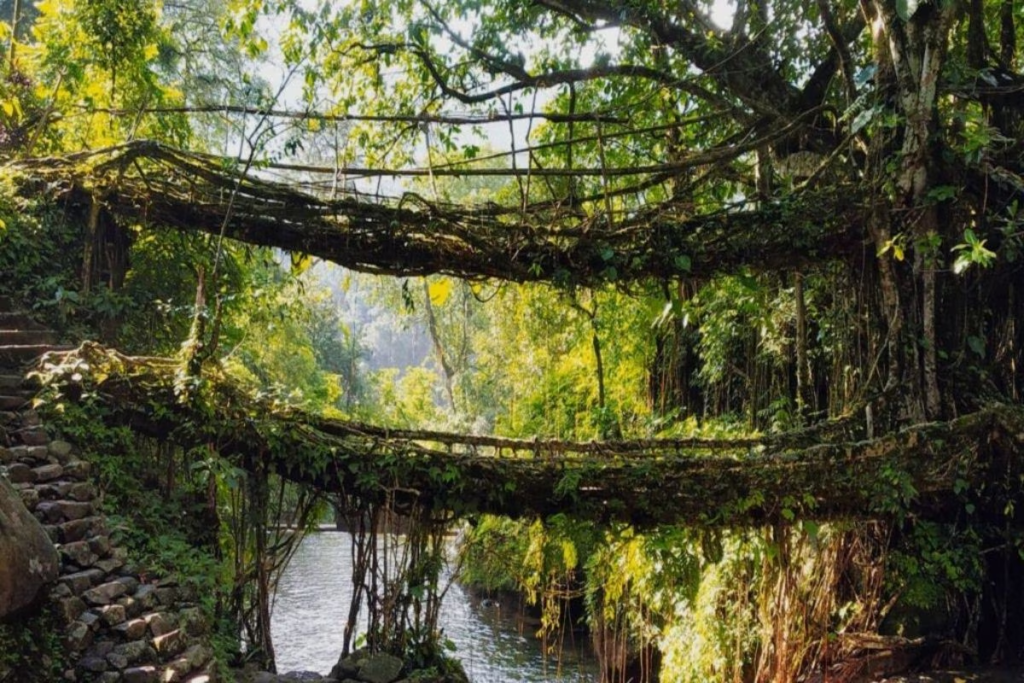
In the remote corners of Northeast India lies a hidden gem, a testament to nature’s engineering prowess that has left the world awe-inspired – the Living Roots Bridge. These remarkable structures are not only an engineering marvel but also a living embodiment of the harmonious relationship between humans and their environment. In this article, we will take you on a journey through the lush rainforests of Meghalaya to unravel the secrets of these incredible living bridges.
TABLE OF CONTENTS
- Introduction
- The Living Roots Bridge: Nature’s Masterpiece
- 2.1 The Origins of Living Root Bridges
- 2.2 How Are They Constructed?
- The Village of Cherrapunji: A Bridge Haven
- Strength and Durability
- Ecological Significance
- 5.1 Biodiversity Hotspot
- 5.2 Sustainable Architecture
- Cultural and Social Relevance
- The Visitor’s Experience
- 7.1 Trekking Adventures
- 7.2 Cultural Immersion
- Preservation Efforts
- Challenges Ahead
- The Future of Living Roots Bridges
- Conclusion
1. Introduction
Hidden deep within the state of Meghalaya, India, lies a natural wonder that seems almost too incredible to be real – the Living Roots Bridges. These extraordinary structures, handcrafted by generations of Khasi and Jaintia tribes, are living examples of sustainable architecture and coexistence with nature. In this article, we delve into the fascinating world of these bridges that have stood the test of time and nature’s fury.
2. The Living Roots Bridge: Nature’s Masterpiece
2.1 The Origins of Living Root Bridges
The roots of this ingenious engineering concept can be traced back centuries. The indigenous Khasi and Jaintia tribes discovered that the roots of the Ficus elastica tree were particularly well-suited to create sturdy bridges. They began guiding the roots to grow across streams and rivers, a practice known as ‘bioengineering.’
2.2 How Are They Constructed?
Constructing a living roots bridge is a patient labor of love. Young roots are trained to grow through hollowed-out betel nut tree trunks that serve as the bridge’s framework. Over the years, these roots strengthen and thicken, creating robust and resilient bridges that can last for centuries.
3. The Village of Cherrapunji: A Bridge Haven
Cherrapunji, often recognized as one of the wettest places on Earth, is home to some of the most famous living roots bridges. The region’s abundant rainfall contributes to the rapid growth of the bridges, making it an ideal location to witness these natural wonders.
4. Strength and Durability
Living roots bridges are remarkably strong, capable of supporting the weight of dozens of people at a time. Their unique structure allows them to withstand the monsoons, which can be exceptionally harsh in this region.
5. Ecological Significance
5.1 Biodiversity Hotspot
The areas surrounding these bridges are rich in biodiversity, providing habitats for a wide range of species. The interconnected roots and branches of these trees form a complex ecosystem that supports countless organisms.
5.2 Sustainable Architecture
Living roots bridges represent a sustainable way of building infrastructure without harming the environment. Unlike conventional bridges, they grow stronger with time and contribute to the preservation of the forest ecosystem.
6. Cultural and Social Relevance
For the Khasi and Jaintia tribes, living roots bridges are not just functional; they are an integral part of their culture. These bridges are a symbol of the harmonious relationship between humans and nature and serve as a cultural heritage site.
7. The Visitor’s Experience
7.1 Trekking Adventures
Visiting these bridges offers an unforgettable trekking experience through lush green forests, steep valleys, and picturesque landscapes. Trekkers can explore the bridges and witness the breathtaking beauty of Meghalaya’s terrain.
7.2 Cultural Immersion
Travelers also have the opportunity to immerse themselves in the rich tribal culture of the region. Interacting with the locals and participating in their customs and traditions provides a unique cultural experience.
8. Preservation Efforts
As these bridges gain international recognition, efforts are underway to preserve and protect them. Conservation initiatives aim to ensure that these living wonders continue to thrive for generations to come.
9. Challenges Ahead
While the living roots bridges have endured for centuries, they face challenges from modernization and environmental changes. Finding a balance between preservation and development is crucial for their survival.
10. The Future of Living Roots Bridges
The future of these natural wonders is uncertain, but the resilience of both the bridges and the communities that nurture them offers hope. With continued efforts, these living bridges can continue to captivate the world.
11. Conclusion
The living roots bridges of Meghalaya stand as a testament to the ingenious ways in which humans can coexist with nature. These living marvels not only bridge physical gaps but also bridge the gap between tradition and modernity. They are a reminder of the beauty and strength that can emerge from the union of man and nature.



